
The Carrollton Viaduct, located over the Gwynns Falls stream near Carroll Park in southwest Baltimore, Maryland, is the first stone masonry bridge built for railroad use in the United States for the Baltimore and Ohio Railroad, founded 1827, with construction beginning the following year and completed 1829. The bridge is named in honor of Charles Carroll of Carrollton (1737-1832), of Maryland, known for being the last surviving signer of the Declaration of Independence, the only Roman Catholic in the Second Continental Congress (1775-1781), and wealthiest man in the Thirteen Colonies of the time of the American Revolutionary War (1775-1783).
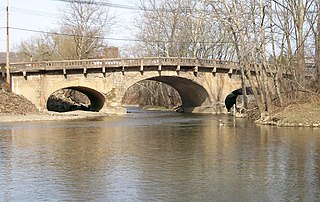
The Elm Grove Stone Arch Bridge, also known as the Monument Place Bridge, is the oldest extant bridge, built in 1817, in the U.S. state of West Virginia. The bridge carries U.S. Route 40 over Little Wheeling Creek in Elm Grove. The bridge was placed on the National Register of Historic Places on August 21, 1981.

The Thorpe Ford Covered Bridge is northeast of Rosedale, Indiana. The single span Burr Arch Truss covered bridge structure was built by Joseph A. Britton in 1912.

Bartlett's Bridge is a historic stone arch bridge carrying Clara Barton Road over the French River in Oxford, Massachusetts. Built in 1889, it is a rare example of late 19th-century stone bridge construction in the state. It was originally built to provide improved capacity for vehicles servicing a nearby textile mill complex. The bridge was listed on the National Register of Historic Places in 2000.

The County Farm Bridge is a historic stone arch bridge in Wilton, New Hampshire. Built in 1885, it carries Old County Farm over Whiting Brook, just south of its northern junction with Burton Highway in a rural section of northwestern Wilton. It is an unusually late and well-preserved example of a 19th-century stone arch bridge, and was listed on the National Register of Historic Places in 1981.

Fewell School is a historic site located in Fewell, Oklahoma. Fewell, 10 miles east of Nashoba, Oklahoma, is a rural community in the Kiamichi Mountains of Pushmataha County, Oklahoma.
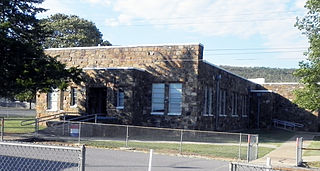
Clayton High School Auditorium is an historic structure serving the public school of Clayton, Oklahoma. Clayton is located in the Kiamichi Mountains of Pushmataha County, Oklahoma.

Grand Forks County Fairgrounds WPA Structures is a collection of five structures within the Grand Forks County Fairgrounds in Grand Forks, North Dakota, that were listed on the National Register of Historic Places in 2009.

Bridge No. 1860, also known as the Samson Occom Bridge, is a fieldstone arch bridge in Montville, Connecticut, United States. Constructed by the Connecticut State Highway Department in 1936 as a Works Progress Administration project, it is located on Mohegan tribal land in an area that was once a part of Fort Shantok State Park. The bridge carries traffic from Massapeag Side Road over the Shantok Brook, a tributary of the Thames River. Spanning 12 feet (3.7 m) across the brook, the bridge's arch rises about 6 feet (1.8 m) above the water. According to a 2011 Connecticut Department of Transportation report, it carries 1,100 vehicles per day. Samson Occom Bridge was listed on the National Register of Historic Places in 1993.
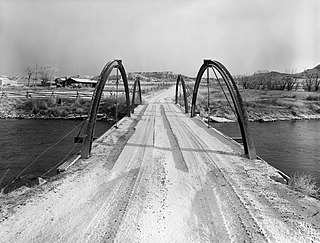
The ELS Bridge over Big Wind River is a pony truss bridge located near Dubois, Wyoming, which carries Fremont County Road CN10-21 across the Big Wind River. The bridge was built circa 1920. Its design is uncommon and merges a kingpost truss with an arched chord. The materials used to build the bridge are also unusual and were likely salvaged; for instance, the arches are made from tunnel sets.
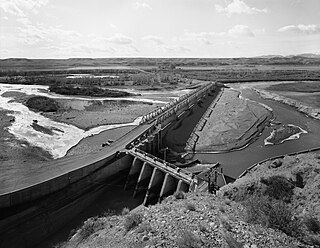
The ELY Wind River Diversion Dam Bridge is a Warren pony truss bridge located near Morton, Wyoming, which carries Fremont County Road CN10-24 across the Wind River. The bridge's structure is integrated with the Wind River Diversion Dam; it was the first truss bridge to be connected with a dam during its construction. The Taggart Construction Company built the bridge from 1924 to 1925. The bridge is 655 feet (200 m) long and has eight spans, making it both the longest road truss bridge in Wyoming and the road bridge with the most spans in the state.

The Samuel Morey Memorial Bridge is a historic bridge carrying New Hampshire Route 25A across the Connecticut River between Orford, New Hampshire and Fairlee, Vermont. The steel through-arch bridge was built in 1937-38 to replace an older wooden bridge which had been damaged by flooding in 1936. It spans 432 feet (132 m), stands about 35 feet (11 m) above the river, and its arches rise 85 feet (26 m) above the roadway. It rests on poured concrete abutments that have a light Art Deco or Moderne styling. Wing walls recede from the abutments into the banks in three stepped sections. Below the bridge in the river is visible some riprap, stone remnants of the old bridge's abutments and central pier. The bridge is of a "tied arch" design, in which the two arches are joined together by ties to distribute the active load. This is in contrast to the Justice Harlan Fiske Stone Bridge joining Brattleboro, Vermont and Chesterfield, New Hampshire, which was built about the same time, and distributes the active load to its abutments. The bridge components were manufactured by the American Bridge Company; construction was by Hagen-Thibodeau Construction Company at a contracted cost of just over $209,000.

The Keel Creek Bridge is a bridge on Oklahoma State Highway 31 seven miles northeast of Coalgate, Oklahoma. The bridge is listed on the National Register of Historic Places. It was constructed as a Works Progress Administration project. The bridge is significant because of its importance to the transportation history of the area and because it is a WPA-built structure.

The Cove Lake Spillway Dam and Bridge are a historic structure in Ozark-St. Francis National Forest, north of Corley, Arkansas. The dam is built of earth and stone, and impounds Cove Lake, location of a recreation area in the national forest. The bridge is a five-span masonry arch structure, built across the dam spillway, where it carries Arkansas Highway 309. The dam and bridge were built in 1937 with funding from the Works Progress Administration, and is a fine example of the Rustic architecture WPA projects were known for.

The Tucker School was a three-room schoolhouse built in 1937 as a Works Progress Administration project in a rural area outside of Spiro in LeFlore County, Oklahoma. It was listed on the National Register of Historic Places in 1988.

The Bridge No. 63-137-90 is a historic bridge near Parker in rural Turner County, South Dakota. It was built sometime between 1934 and 1936, and is one of a large number of surviving stone bridges built as part of federal jobs programs in the county. It was listed on the National Register of Historic Places in 1999 as Bridge No. 63-137-090-Parker.
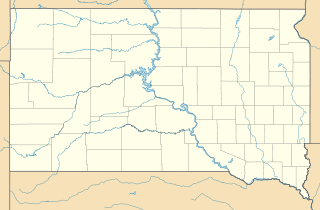
The Childstown Township Bridge Number S-15 is a historic bridge over an unnamed stream on 282nd Street in rural Turner County, South Dakota, west of Hurley. Built in 1940, it is one of a modest number of bridges surviving in the county that was built with New Deal funding. It was listed on the National Register of Historic Places in 2000.

South Dakota Department of Transportation Bridge No. 63-132-040 is a historic bridge in rural Turner County, South Dakota. Built in 1939, it is a well-preserved period stone-arch bridge, built with funding from a New Deal jobs program. It was listed on the National Register of Historic Places in 1999.

The Mill Brook Bridge is a historic stone arch bridge, located just north of Lower Blissville Road in Lisbon, Connecticut. With a plausibly estimated construction date of the 1790s, it is probably the oldest surviving stone arch bridge in the state. It was listed on the National Register of Historic Places in 1997. Since then, it has deteriorated and is partially collapsed.

The Bunnell Coquina City Hall is a unique one-story public building constructed of locally quarried coquina stone. The property is located at 200 South Church Street, Bunnell, FL 32110 in the downtown section of the city. It includes man-made Lake Lucille with its jetting fountain in the front of the building, which creates an impressive visual appeal to the setting of the property. It was built in 1936-1937 with grant funding from the Work Progress Administration WPA.
























